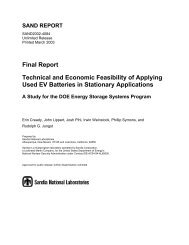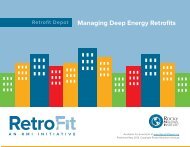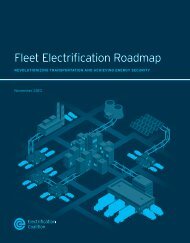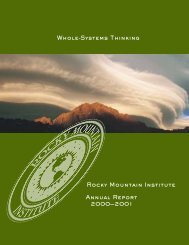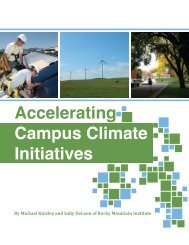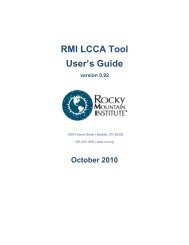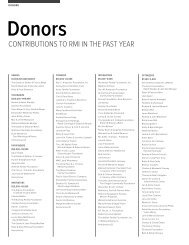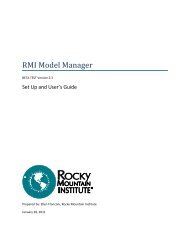Abundance by Design - Rocky Mountain Institute
Abundance by Design - Rocky Mountain Institute
Abundance by Design - Rocky Mountain Institute
- No tags were found...
Create successful ePaper yourself
Turn your PDF publications into a flip-book with our unique Google optimized e-Paper software.
helping to integrate supply and demandsideoptions into risk-managed, least-cost portfolios.The local resource evaluation includesdetailed modeling and economic analysis of thepotential for distributed tri-generation of cooling,heat and power at specific large customer sites.• Helping Great Plains Energy develop the businesscase for demand response and distributed generationprograms with commercial and residential customersof Kansas City Power & LightCompany. RMI evaluated the available technologiesand available products, reviewed a rangeof proposed program designs, prioritized the programsin terms or potential impact, and analyzed the customercash flows and utility economics of a portfolioof programs. RMI also provided demand-side managementtechnology and program reviews and designed astrategy to collect data to support evaluation of futureload management and distributed generation programs.• Developing an approach for defining the futurevalue of GHG emissions as part of the CaliforniaCalifornia Public Utilities Commission’s avoidedcost methodology for demand-side management programs,under subcontract to Energy andEnvironmental Economics (E3). This valuation wasdefined as future cost values (albeit uncertain), whichare a foundation of orthodox utility financial planning,rather than as externalities, which had been previouslyestimated but carried little legal weight. The methodwas adopted in April 2005 for all long-term utilityresource planning and procurement decisions.• Performing a supply risk analysis for theNebraska Public Power District cooperative, comparingthe reliability and economic impacts of extreme riskscenarios on supply portfolios augmented <strong>by</strong> coal,nuclear, natural gas, and renewable resources. Severalscenarios included carbon dioxide emissions limits andcosts. The analysis involved modeling the price interactionsbetween electric, natural gas, coal, and emissionsmarkets under each scenario, as well as identification ofstrategies to mitigate risks related to carbon dioxideemissions and other impacts of each resource.• For a leading information technology firm,identifying and evaluating a range of potential investmentsin clean energy technology and other GHG mitigationmeasures. Based on the evaluation results, weare prioritizing these measures to assemble arobust portfolio ofcarbon offsets to balancecorporate emissions to meet thefirm’s economic, environmental, social andpractical criteria.• Helping San Diego Gas and Electric managementrealign its demand-side programs with the latesttechniques for integrative design (which make savingslarger but cheaper) and for making markets in savedelectricity (so more market actors are rewarded forfaster savings).• Conducting a series of briefings for the investmentbank Crédit Lyonnais S.A.’s clients in the financialservices industry. The briefings—in Europe, Asia, andNorth America—are ongoing, and they cover corporatecarbon management strategies, technical options forcarbon dioxide emission reductions, and implicationsof present and future carbon constraints for shareholdervalue in a range of industries and firms.• Our work with fossil fuel producers also offersopportunities to shift their strategies. For example, atleast one large coal-mining firm we work with isstarting to view its coal assets through the lens of thehydrogen value chain—potentially the highest andbest use of coal in a carbon-constrained world.<strong>Rocky</strong> <strong>Mountain</strong> <strong>Institute</strong> Annual Report: 2004–057



